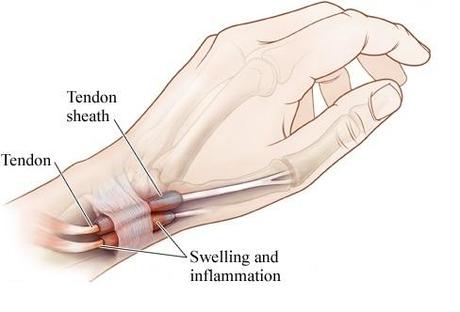 What is De Quervain Tenosynovitis?
What is De Quervain Tenosynovitis?
De Quervain Tenosynovitis, otherwise known as De Quervain Tendinosis, is a painful inflammation of specific tendons that extend the thumb.
The swollen tendons and their coverings cause friction within the narrow tunnel or sheath through which they pass. The result is pain that may extend from the forearm to the thumb base. De Quervain’s was named after the Swiss surgeon who first described the condition in 1895. In 1895, a Swiss surgeon, Fritz de Quervain, published 5 case reports of patients with a tender, thickened first dorsal compartment at the wrist.
The condition has subsequently borne his name, De Quervain tenosynovitis and is currently one of the most common types of tendon lining inflammation.
What are the symptoms of De Quervain Tenosynovitis?
The main symptom of de Quervain’s tenosynovitis is pain or tenderness at the base of your thumb. You might also feel pain going up your forearm. The pain may come on suddenly or develop slowly. It may get worse when you use your hand and thumb.
Other symptoms of de Quervain’s tenosynovitis include the following:
- Pain along the thumb side of wrist most common.
- May radiate down to the end of the thumb or up along the thumb side of the forearm.
- Pain is most commonly felt when reaching the thumb across the palm or when (bending) the wrist and turning it towards the little finger (ulnar deviation).
- Pain may also be felt when pressure is applied over the tendons that run along the outside of the thumb and wrist.
Understanding the Anatomy
Two of the main tendons to the thumb pass through a tunnel (or series of pulleys) located on the thumb side of the wrist. Tendons are rope-like structures that attach muscle to bone. Tendons are covered by a slippery thin soft-tissue layer, called synovium. This layer allows the tendons to slide easily through a fibrous tunnel called a sheath.
Any swelling of the tendons and/or thickening of the sheath, results in increased friction and pain with certain thumb and wrist movements.
What causes De Quervain Tenosynovitis?
Overuse, a direct trauma or injuries to the thumb, repetitive grasping and certain inflammatory conditions, such as rheumatoid arthritis, can all trigger the disease. Gardening, racquet sports, and various workplace tasks are some activities that can aggravate the condition. It is also seen during the last trimester of pregnancy and in mothers of nursing children. Often, its cause is unknown. De Quervain’s affects women eight to 10 times more often than men. People who engage in activities that require sidewise motion of the wrist while gripping with the thumb (e.g., hammering, skiing) may be more likely to develop the condition.
Pain along the back of the thumb, directly over the two thumb tendons – the extensor pollicis longus brevis and the abductor – is typical of de Quervain’s. The condition can occur gradually or suddenly. In either case, the pain may travel into the thumb or forearm. Thumb motion may be difficult and painful, particularly when pinching or grasping objects. Some people also experience swelling and pain on the side of the wrist at the base of the thumb. The pain may increase with thumb and wrist motion. Some people also feel pain if direct pressure is applied to the area.
Treatment for De Quervain Tenosynovitis (De Quervain Tendinosis) in Augusta GA
As one of the few Augusta GA Chiropractors that are able to provide FDA approved Cold Laser treatments, we have had tremendous success with repetitive strain injuries (RSI) that result in persistent or recurring pain from overuse of muscles and tendons. Our patients who have come in with De Quervain Tenosynovitis have had great success with our cold laser treatments.
By being able to customize treatment specifically for De Quervain Tenosynovitis, we have been able to reduce the pain, strengthen the muscles and increase range of motion. Most importantly our customized treatments help reduce the inflammation and swelling, which is the main cause behind De Quervain Tenosynovitis.
With no side effects associated with cold laser, many of our patients were able to not only successfully treat their De Quervain Tenosynovitis, but they were able to avoid surgery and the complications that can arise from it.
We welcome you to schedule a complimentary consultation at Georgia Clinic of Chiropractic to find out if our customized treatments are the right fit for your condition.
The Georgia Clinic of Chiropractic Blog is written by Dr. Mark Huntsman.
Augusta GA Chiropractor Georgia Clinic of Chiropractic provides customized treatments to Augusta GA, Martinez GA, and Evans GA patients. Visit the main website at www.georgia-clinic.com for a chiropractor in Augusta GA.
Choose several options to schedule your appointment: call (706) 814-5053 or use our online form.
